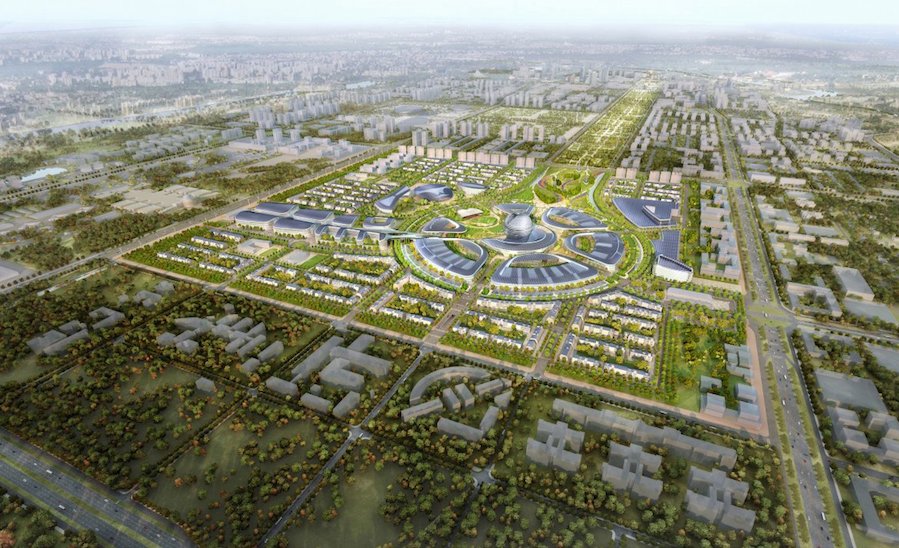Kazakhstan Seeks Attention With Multi-Billion-Dollar Expo Build
Former Soviet nation and US designer push energy-efficient innovations

Energy sustainability is a key focus for EXPO 2017 (center) and high-profile upgrade of Kazakh capital of Astana.
Photo: Adrian Smith + Gordon Gill
AT THE EXPO 2017 SITE IN ASTANA, KAZAKHSTAN—Even with a highly depreciated currency and an economy battered by the oil price slump, the former Soviet nation of Kazakhstan is ramping up completion of EXPO 2017 and its surroundings in the capital of Astana—a futuristic megaproject estimated to cost between $3 and $5 billion that will showcase global energy efficiency but also promote the Central Asian nation's push to modernize and raise its worldwide profile.
The first international exhibition to be held in Central Asia and in a former CIS country, "Future Energy" will host 3 million visitors between June and September of next year and create what its Chicago-based designer Adrian Smith and Gordon Gill (AS+GG), said will make Astana “the first Third Industrial Revolution city where energy consumed by the Expo community will be provided from renewable sources.” Buildings will generate their own power that will be distributed by a smart grid.
Participants tell ENR that despite archaic construction rules and the unforeseen oil-sector crash since EXPO 2017 was awarded to Kazakhstan in 2012 and work started in 2014, national pride and an iron administration led by its government-owned company are pushing forward.
Akhmetzhan Yessimov, chairman of JSC National Company that is running EXPO 2017, confirmed in June to the Paris-based intergovernmental group that supervises international exhibitions, that construction will be done by year-end.
Yessimov was appointed last August in the wake of an alleged corruption scandal involving EXPO 2017 managers who have since been arrested, terminated or have left, say local news reports. He had been mayor of Almaty, a Kazakh city that lost the 2022 Winter Olympics to Beijing in July 2015 by just four votes. Almaty now is vieing for the 2026 Games, set for award in 2019. Officials had claimed last year that 80% of venues would be completed in 2017.
AS+GG won the design for EXPO 2017 and Astana against 49 competitors. “The design was chosenfor its uniqueness and it could also relate to the architecture of Astana’s contemporary buildings,” Alisher Pirmetov, the exhibition's first deputy, told ENR. Flashy glass and metal buildings dot Astana’s surrealist skyline.“The urban design for Expo City was determined by site specific indicators such as weather conditions, cultural context and land accessibility.” Astana is the second coldest capital city after Ulaanbaatar, Mongolia.
Split into two phases, the 430-acre project with 62 dedicated to EXPO 2017 will feature 97 pavilions; a residential development; and related retail, cultural, educational and civic facilities.
A subsequent phase of development will see the buildings converted into an office, research and financial center, a pet project of Kazakh President Nursultan Nazarbayev.
Pirmetov said the concept was being worked on and other such centers “are being studied.” He added,that the start of Phase 2 would depend on “interest from investors.”
The centerpiece of EXPO 2017 is the iconic 8-story-high, 80 meter-dia globe with a transformative skin and geothermal reserves underneath. Its design includes high-performance glazing that will maximize solar heat gain in winter while providing shading in summer. Energy piles will reduce exposed thermal mass that will provide temperature modulation within the buildings during both summer and winter, said AS+GG. Turkey's Sembol Group is the main project contractor. The metallic structure contains 12,000 tons of steel.
“The sphere by itself is an innovation," said Serdar Güçar, regional vice president and managing director, at Hill International, the project's program manager. "The façade made in Italy is unique as it is not smooth, but curved. He says the sphere includes solar photovoltaic panels. "The way glass parts attach to the surface of the structure is part of the design,” he said.
Challenges were many, with each piece of glass weighing 800 kg, requiring use of 80kg cranes.Building regulations, old Soviet approaches later combined with more modern western codes, sometimes created issues.
Other key contractors include Swiss-based Mabetex Group, a Russian company and two Kazakh contractors, YDA Group and SAES Sredazenergostroy.
All have signed up Kazakh subcontractors as part of the government's effort to provide jobs to locals, which includes convicts. The labor force totaled 5,000 at construction peak, also including migrant workers from neighboring countries. Pirmetov acknowledged workmanship of the kind that was required for the sphere could not be done locally “because of the scale and pressure.”
Every project has its own vagaries and “that’s what project management is all about,” said Güçar. “Coordination becomes an issue with inefficiencies created by different contractors for different buildings.” About 254 local companies are at work on the construction site.
Graft has also hurt. In June, EXPO 2017's former chairman was found guilty of embezzling millions of dollars in project funds and sentenced to 14 years in prison. The project's former construction department chief will spend two years behind bars, found guilty of abuse of power and embezzlement.





